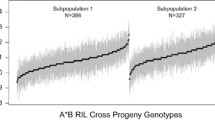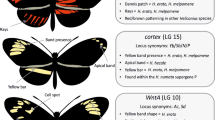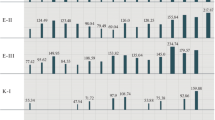Abstract
The aristae ofDrosophila have been shown to play a role in mating behavior and geotaxis. Two populations ofD. melanogaster were selected for increased and decreased numbers of major aristal branches. Selection was successful and resulted in two lines differing by an average of six aristal branches. Hybridization analyses of selected lines revealed that genes influencing aristal branching are located on both the X chromosome and the autosomes. Polygenic control of aristal morphology is indicated by a gradual response to selection and low realized heritabilities. When selection was relaxed for 19 generations, the number of aristal branches did not revert to the number in the control line. Changes in aristal branching did not appear to have a consistent influence on geotaxis, although there was a tendency for flies with fewer aristal branches to be geonegative. Neither mating speed nor ethological isolation between the two populations was affected by selection. It is concluded that the number of aristal branches inDrosophila is a neutral trait (i.e., not subject to natural selection) under laboratory conditions. Correlations between aristal morphology and behavior found in other selection experiments by previous investigators were likely due to linkage disequilibria.
Similar content being viewed by others
References
Barnes, B. W. (1968). Stabilizing selection inDrosophila melanogaster.Heredity 23:433–442.
Bennet-Clark, H. C., and Ewing, A. W. (1970). The love song of the fruit fly.Sci. Am. 223:85–92.
Bennet-Clark, H. C., Dow, M., Ewing, A. W., Manning, A., and von Schilcher, F. (1976). Courtship stimuli inDrosophila melanogaster.Behav. Genet. 6:93–95.
Clayton, G. A., Morris, J. A., and Robertson, A. (1957). An experimental check on quantitative genetical theory. I. Short term responses to selection.J. Genet. 55:131–151.
Dobzhansky, T., and Spassky, B. (1962). Selection for geotaxis in monomorphic and polymorphic populations ofDrosophila pseudoobscura.Proc. Natl. Acad. Sci. 48:1704–1712.
Dobzhansky, T., and Spassky, B. (1967). Effects of selection and migration on geotactic and phototactic behaviour ofDrosophila. I.Proc. R. Soc. Lond. Ser. B.168:27–47.
Ehrman, L. (1965). Direct observation of sexual isolation between allopatric and between sympatric strains of differentDrosophila paulistorum races.Evolution 19:459–464.
Ehrman, L., and Petit, C. (1968). Genotype frequency and mating success in thewillistoni species group ofDrosophila.Evolution 22:649–658.
Ewing, A. W., and Bennet-Clark, H. C. (1968). The courtship songs ofDrosophila.Behaviour 31:287–301.
Falconer, D. S. (1960).Introduction to Quantitative Genetics, Ronald, New York.
Flugge, C. (1934). Geruchliche Raumorientierung vonDrosophila melanogaster.Z. Vergl. Physiol. 20:463–500.
Fuller, J. L., and Thompson, W. R. (1960).Behavior Genetics, Wiley, New York.
Hirsch, J. (1959). Studies in experimental behavior genetics. II. Individual differences in geotaxis as a function of chromosome variations in synthesizedDrosophila populations.J. Comp. Pysiol. Psychol. 52:304–308.
Kellogg, F. E., Frizel, D. E., and Wright, R. H. (1962). The olfactory guidance of flying insects. IV.Drosophila.Can. Entomol. 94:884–888.
Lerner, I. M. (1954).Genetic Homeostatis, Oliver and Boyd, Edinburgh.
Manning, A. (1961). The effects of artificial selection for mating speed inDrosophila melanogaster.Anim. Behav. 9:82–92.
Manning, A. (1967). Antennae and sexual receptivity inDrosophila melanogaster.Science 158:136–137.
Pasteur, G. (1969). Morphological differences betweenDrosophila pseudoobscura populations selected for opposite geotaxes and phototaxes.Genetics 62:837–847.
Petit, C. (1958). Le déterminisme génétique et psycho-physiologique de la competition sexuellé chezDrosophila melanogaster.Bull. Biol. Paris 92:248–329.
Pyle, D. W. (1976). Effects of artificial selection on reproductive fitness inDrosophila.Nature 263:317–319.
Pyle, D. W. (1978). Correlated responses to selection for a behavioral trait inDrosophila melanogaster.Behav. Genet. 8:333–340.
Sokal, R. R., and Rohlf, F. J. (1969).Biometry, Freeman, San Francisco.
Spieth, H. T. (1974). Courtship behavior inDrosophila.Ann. Rev. Entomol. 19:385–403.
Author information
Authors and Affiliations
Additional information
This work was supported by NIH Grant GM 23706 and NSF Grant DEB 77-14994 to R. C. R.
Rights and permissions
About this article
Cite this article
Pyle, D.W., Richmond, R.C. Genetic basis of aristal morphology inDrosophila melanogaster and its correlation with behavior: Selection for increased and decreased aristal branching. Behav Genet 9, 297–308 (1979). https://doi.org/10.1007/BF01068208
Received:
Accepted:
Issue Date:
DOI: https://doi.org/10.1007/BF01068208




